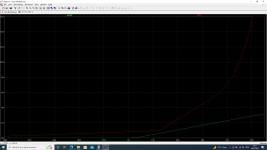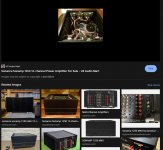Without going overkill… what’s the minimum number of output devices needed to run a 4 ohm resistive load close to clipping assuming….
- +/-110vdc rails unloaded.
- 1.6kva Toroids ( two 800va units with single 0-80vac taps unloaded)
- 4x 33,000uF caps (160v)
- Class AB Config
- 0.47R emitter resistors with about 6-8mV across each device.
- Assume adequate heatsinking and MJL4302/4281 Or MJL21193/94 devices…
Transistors are cheaper than technicians. Don't say "minimum". Use LOTS.what’s the minimum number
I like 50 Watts audio per pair of TO-3 parts.
Commercially, 1.6kVA of iron suggests 800 Watts audio or sixteen pairs.
I don't know what most of your specs are supposed to say?
And I don't know why they want to push an amp towards clipping.Transistors are cheaper than technicians. Don't say "minimum". Use LOTS.
I like 50 Watts audio per pair of TO-3 parts.
Commercially, 1.6kVA of iron suggests 800 Watts audio or sixteen pairs.
I don't know what most of your specs are supposed to say?
Or even worry about clipping levels.
1500 watts peak power dissipation. Highest power dissipation does not occur at clipping. 55 volts, 27.5 amps (half way up the rail at 2 ohms resistive) or 110 volts at 13.25 amps (Half the peak current at 4 ohms for 60 degrees reactive). Plus margin. Tall order for anything but MJL4281’s. If you are not going H-class so you have less Vce, consider two banks in series parallel so you can get full power handling out of them. I did this on +/-127 volts with 10 metal cased 21194 in series parallel and no problems with 2 ohm real world loads. Other than the horrendous power draw.
Heat sinking is dictated by by the average dissipation. Vcc**2/(10RL) per bank is the maximum, with music it’s 1/4 to 1/2, depending on how hard you run it.
Heat sinking is dictated by by the average dissipation. Vcc**2/(10RL) per bank is the maximum, with music it’s 1/4 to 1/2, depending on how hard you run it.
If you are considering BJT transistors, although 220V transistors are available, the SOA issue remains for any amp running more than +/-30V. The solution is a class G or better class H, 3 or 4 deep. Or +/-55V bridged. However, 110*110/4/2 = 1512.5 Watts, and a linear amp at those power levels is a dubious idea.
And the rational use of an amp that big are limited to stadiums and shake tables. I'm sure there are sub speaker vendors who claim that kind of power but do any of them actually survive more than 10 seconds? Burning up speakers is a sport some enjoy, but I would not support them.
And the rational use of an amp that big are limited to stadiums and shake tables. I'm sure there are sub speaker vendors who claim that kind of power but do any of them actually survive more than 10 seconds? Burning up speakers is a sport some enjoy, but I would not support them.
👍Commercially, 1.6kVA of iron suggests 800 Watts audio or sixteen pairs.
An example, the Coda No.8 stereo power amp:
Each channel has eight pairs of bipolar MJL4281A / MJL4302A and two pairs of ThermalTrak NJL3281D / NJL1302D, In total of 20 output transistors in each channel.
Power supply is a 3kVA transformer with 80,000uF filter caps, capable of delivering 400 watts at 8 ohms and 800 watts at 4 ohms per channel and up to 8W operates in class A.
And this amp is to be used for what?👍
An example, the Coda No.8 stereo power amp:
Each channel has eight pairs of bipolar MJL4281A / MJL4302A and two pairs of ThermalTrak NJL3281D / NJL1302D, In total of 20 output transistors in each channel.
Power supply is a 3kVA transformer with 80,000uF filter caps, capable of delivering 400 watts at 8 ohms and 800 watts at 4 ohms per channel and up to 8W operates in class A.
Outdoor entertainment I would think?
What about Class AB using a variable voltage switching supply?
Class A then an a viable voltage supply takes over? More class G? H? but something Carver did years ago.
However once you have an SMPS with a input voltage SMPS then you have Class D. You could do a bridged class A switcher in that form (and damn the energy).. the resulting SMPS never has a negative voltage transition to cope with (I'm assuming a zero transition high current would cause the switcher problems).
However that's switched and not class A.. but class D with a serious bias burn!
Also this is one thing I think you've missed - bridged amplification.
Class A then an a viable voltage supply takes over? More class G? H? but something Carver did years ago.
However once you have an SMPS with a input voltage SMPS then you have Class D. You could do a bridged class A switcher in that form (and damn the energy).. the resulting SMPS never has a negative voltage transition to cope with (I'm assuming a zero transition high current would cause the switcher problems).
However that's switched and not class A.. but class D with a serious bias burn!
Also this is one thing I think you've missed - bridged amplification.
Without going overkill…
+/-110vdc rails unloaded.
Yes... I see... definitely no overkill here...
Enough MJL1302/3281 to handle the current.
MOSFETs as bootstrapped cascodes to handle the dissipation. Vce about 10V on the bipolars. Less Cbe in parallel, easier to drive, lower emitter resistor values, thus less crossover distortion, less self-heating, less bias drift... MOSFETs are cheaper too... Look at FDA59N25 and similar FETs, 0.32°C/W, ridiculous SOA...
What else would one use it for? There are people here that do that. Although the Pro Audio Community general discourages anyone from building their own gear for a variety of reasons. But if it’s not your primary means of support I see no reason not to combine two “hobbies”.And this amp is to be used for what?
Outdoor entertainment I would think?
It would only really require 2-deep class H to be practical - the market WAS full of RMX2450 clones until class D fully took over. And it’s about the right size for a bar band or to DJ with. Eliminates the 110 volt SOA requirement that’s a bitch no matter how you look at it. But that would require the toroids to be the usual 40-0-40’s - and I’m assuming you’re using what you have on hand, presumably obtained cheaply. It‘s how I do this - at full prices you can‘t build one of these for less than about 3 grand. Cheap/free transformers, soup can caps, heat sinks and chassis change that equation and make it do-able. Fully AB class is possible, but will tax the hell out of a 20A circuit and require a TA450 fan running on high all the time. When I built mine, they were mono blocks and each fed from its own outlet. I ran two lab horns (the original design) off each and damn near melted the plugs off the extension cords doing music at a fireworks show. That was very little drama compared to what happened when the trailer contains the fireworks caught fire. At least we didn’t need the music up that high anymore or there might have been an electrical fire in a place not as expendable. Do not underestimate the current draw if you’re cranking something like this to 11.
the rational use of an amp that big are limited
Outdoor entertainment I would think?
Why not? Why must all questions be filtered through "the reader's" lifestyle? 800W clipping may be unpopular in your row-home, but at least two of my mile-away neighbors run that much weekly. In a past life I used to carry 750 Watts of tubes to the concert in the park. Clipping was expected. It "isn't loud enough" without IM.
Its up to the users to determine how they want to use anything they build or purchase...And this amp is to be used for what?
Outdoor entertainment I would think?
I have all the parts, I collected over the years. except the Toroids, which I can get "relatively cheap" Less than $180 shipping included. I have some other toroids (40-0-40, 45-0-45, 60-0-60, 65-0-65) that I can sell and get these 75-0-75 units... I have the chassis with large sinks (Sonance 1250 see pic ) that is rated for 1200w dissipation total. I currently have a class AB design on another one of these Sonances (I have 2-3 of these I got cheaply) with +/-90vdc rails runs cool and very authoritative makes my Krell 250a feel a bit anemic. I have about 60-70 Mjl4302/4281's lying around, plus the caps, clamps etc... so cost is minimal given what I have hoarded already...
I already have a kit in mind for this "headphone" amplifier 😉
PRR/wg_ski/bimo/chrisng/nigel, thanks for the responses and sticking to the question asked...
I already have a kit in mind for this "headphone" amplifier 😉
PRR/wg_ski/bimo/chrisng/nigel, thanks for the responses and sticking to the question asked...
Attachments
Might be a 1200 watt total amplifier, but that’s not the same as average dissipation. Each one of those heat sinks will probably get pretty dam hot dissipating 600 watts in free air. Use power resistors to measure it - then you can get the actual thermal rise — after a good hour to reach operating temp. Those are some big heat sinks. Plenty big enough if you clamshell two of them and use forced air thru the center. Used “gently” as a hi-fi amp on steroids it would run cooler than an old Phase Linear - real world dissipation about 150W average watts per side. But forced air required for DJ or PA use for sure where the figures would be double or quadruple.
Fans will certainly be installed once the sinks get over 55c in normal use. I just have never done this before... trying to put one under the belt I guess.. 🙂
I could also use the other one I built on 90vdc rails and just switch out the main board and transformers.... those have 16 MJ21193/4 per channel... will save me a lot of drilling etc too... good test bed.
I could also use the other one I built on 90vdc rails and just switch out the main board and transformers.... those have 16 MJ21193/4 per channel... will save me a lot of drilling etc too... good test bed.
To up the voltage to 110 from 90 it would be a good idea to use 4281/4302 due to the higher SOA above 80 volts. The old QSC USA1310 used 8 each 15024 and 5 per channel on +/-93, and that’s about as high as you can push it. Unless you consider series-parallel.
The 1310 is 2 ohm rated. Mine 4 ohms so half the devices needed, but with 17v higher rails, doubling them makes sense. So 8 pair of 4281/4302 seems to be the way to go. 15a fast blow on the speaker should be added safety
Yes, I would agree. As a commercial reference, I had a Crown CE-2000 on my bench a few years ago, which is rated at 975 W / ch at 4 ohms, with +/- 98V rails and 6 pairs of MJ21194 / ch in quasi-comp. with fan cooling. Fairly close to your plans.So 8 pair of 4281/4302 seems to be the way to go.
I still have the service manual, if you're interested.
- Home
- Amplifiers
- Solid State
- Thought experiment on size of output stage....

